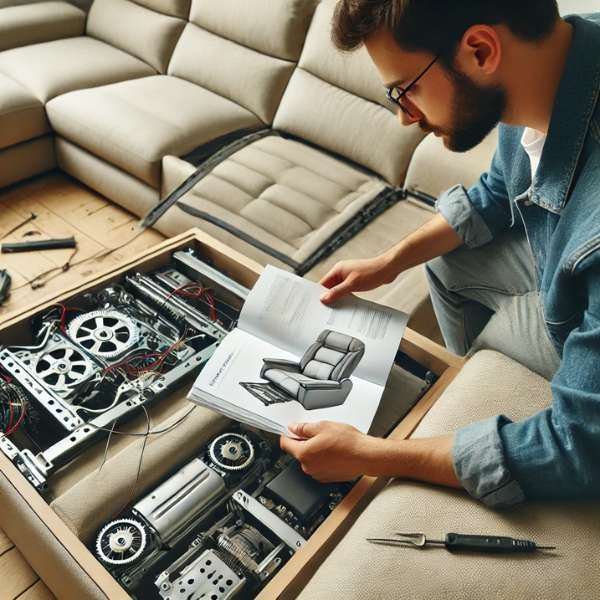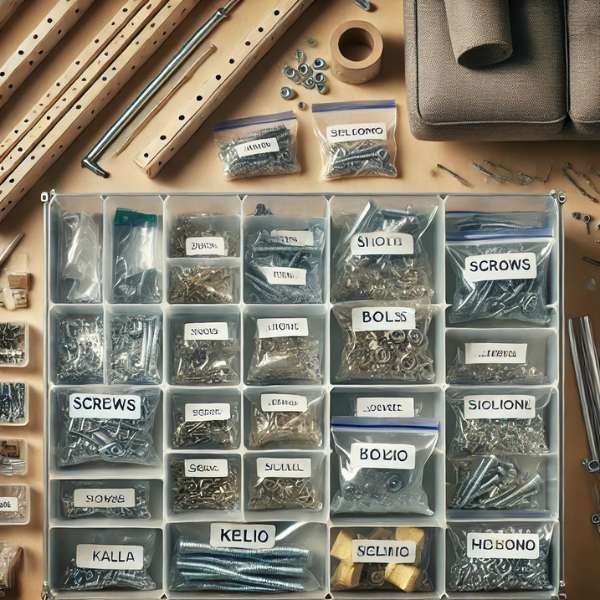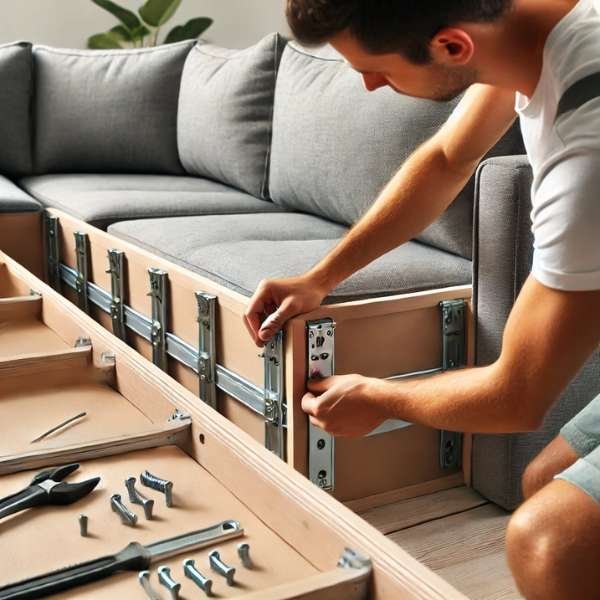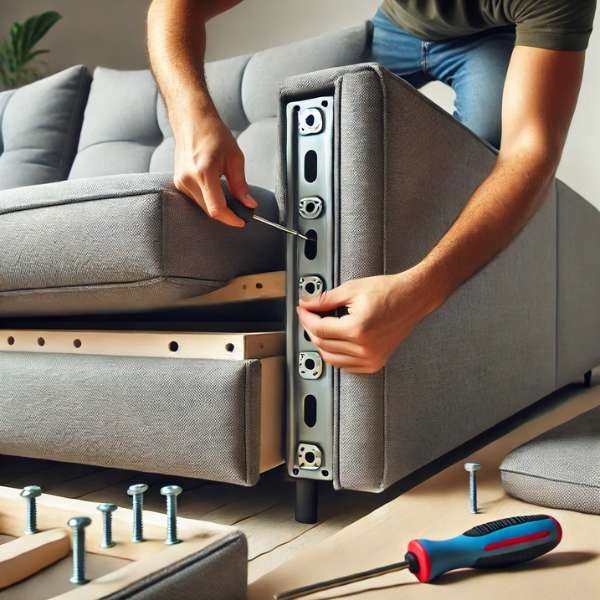Taking apart a sectional sofa might seem overwhelming, but it doesn’t have to be. Whether you’re moving to a new home or simply rearranging your living space, learning how to take apart a sectional sofa can save you time and effort. With a few simple tools and a bit of know-how, you can disassemble your divisional sofa with ease, making it more manageable to transport or store. In this guide, we’ll break down the steps to help you take apart your divisional sofa without hassle.
Why You Might Need to Take Apart a Sectional Sofa

There are many motives why a person might want to dismantle a divisional sofa. Perhaps you’re moving to a brand new domestic, and the bulky layout of the couch makes it almost impossible to move without breaking it down into smaller, greater potential pieces. Or maybe you’re rearranging your living room and need to experiment with a brand-new layout. Another not unusual motive is protection; from time to time divisional sofas want a deep smoothness, and taking them apart allows you to attain crevices that are otherwise inaccessible. Whatever your motivation, disassembling your sectional couch is a talent worth mastering.
Benefits of Learning How to Take Apart Your Sectional Sofa

Knowing how to take aside your divisional sofa gives you the liberty to effortlessly adapt your residing area. It’s additionally a value-effective ability; instead of hiring movers or technicians, you could cope with the project yourself, saving money and time. Additionally, this understanding can increase the lifestyle of your couch, as taking it apart for regular cleaning or protection enables hold the structure and fabric. Over time, learning this talent can give you more manipulate over your own home’s appearance and capability.
Understanding the Structure of a Sectional Sofa
What Exactly Is a Sectional Sofa?

A sectional couch is a versatile piece of furnishings composed of more than one section that may be arranged in diverse configurations to fit exclusive spaces. The beauty of sectional lies in its modularity—every piece connects to form an entire seating area, imparting flexibility in layout and location. divisional couches regularly encompass additives which include chaise lounges, corner units, and normal seating sections, all of which may be rearranged to create anything from an L-form to a U-form.
Types of Sectional Sofas and Their Differences

divisional sofas come in a wide variety of styles, each offering unique benefits. There are traditional sectionals with fixed back cushions, modular sectionals that allow you to move pieces independently, and reclining or sleeper sectionals that add extra functionality. The main difference lies in how the sections are attached—some are connected with hooks, while others use clamps or brackets to secure the pieces. Understanding your specific type of sectional will help when it’s time to take it apart.
Key Components of a Sectional Sofa You Should Know

Before you start disassembling your couch, it’s important to make yourself familiar with its key components. These encompass the body, cushions, connecting brackets, legs, and any specialized capabilities such as reclining mechanisms or pull-out beds. Knowing how these elements suit collectively will provide you with a clearer image of what to anticipate at some point in the disassembly procedure.
Preparation Before Taking Apart Your Sectional Sofa
Tools You’ll Need for the Job

Before you dive into the task, gather the necessary tools. You’ll likely need a screwdriver, pliers, an Allen wrench, and possibly a hammer for stubborn sections. If your sectional uses clips or brackets, a pair of locking pliers can be helpful for securing or loosening these pieces. Keep a soft cloth nearby to prevent scratching the upholstery during the process.
Choosing the Right Workspace for Disassembly

Choosing the right space to work in is crucial. You’ll need a large, flat surface with enough room to spread out the different sections of the couch. Make sure the area is well-lit and free from obstacles. It’s also a good idea to lay down a protective sheet or blanket to prevent damage to the floor and the sofa’s fabric.
Safety Tips for a Smooth Process

Disassembling a divisional couch can involve some heavy lifting, so it’s important to prioritize safety. Always lift with your legs, not your back, and ask for help when handling larger sections. Be mindful of sharp edges on metal brackets or screws, and wear gloves if necessary to protect your hands.
Step-By-Step Guide to Taking Apart a Sectional Sofa
Detaching the Cushions and Pillows: The First Step

Begin by removing all the cushions and pillows. This not only makes the couch lighter but also gives you better access to the structural components. Set the cushions aside in a clean area to prevent dust or dirt from accumulating on them.
Removing the Sectional Sofa Arms

Begin by focusing on the detachable arms of your divisional. Use a screwdriver or wrench to remove any screws or bolts securing the arms to the frame. Place all hardware in a labeled bag for easy reassembly.
Unfastening the Connecting Brackets or Clips

Most divisional sofas are held together by connecting brackets or clips that keep the individual sections securely in place. Use your pliers or a screwdriver to loosen these fasteners. Depending on the design, you may need to lift or slide the sections to disconnect them.
Separating the Individual Sections Safely

Once the brackets or clips are unfastened, gently separate the sections. Take your time, ensuring that you’re not forcing anything apart, which could cause damage to the frame or upholstery.
Disassembling the Reclining or Sleeper Section (if applicable)

For sectionals with a reclining or sleeper component, extra caution is required during disassembly. Refer to the manual for specific instructions, as these sections often have intricate mechanisms that require careful handling.
Handling Difficult Parts During Sofa Disassembly
How to Deal with Stubborn or Hidden Screws

Sometimes screws are hidden deep within the couch’s frame or upholstery. Use a flashlight to locate these difficult parts, and take extra care not to strip the screws while removing them.
What to Do When the Sections Won’t Separate Easily

Check for any overlooked fasteners or clips if sections aren’t coming apart easily. Hidden brackets may be located in areas that aren’t immediately visible, so inspect thoroughly before applying force.
Proper Storage of Sectional Sofa Parts After Disassembly
Labeling and Organizing Hardware for Reassembly

Properly labeling and organizing your hardware is crucial for smooth reassembly. Use small bags or containers to store screws, bolts, and other small components, labeling them according to where they belong.
Storing Large Parts Like Frames and Cushions Efficiently

Store the bigger pieces of the divisional in a dry, clean area. Make certain to keep the cushions off the floor to prevent any moisture buildup or harm to the material.
How to Maintain Your Sectional Sofa During Disassembly
Protecting the Upholstery While Taking It Apart

Cover the upholstery with a smooth sheet or cloth to prevent scratches or stains at the same time as you work. Be specifically cautious when handling sharp tools close to the cloth.
Checking for Wear and Tear While Disassembling

As you’re taking aside the couch, look at the frame and cushions for any signs of wear and tear or harm. This is a wonderful time to carry out minor maintenance or cleaning before reassembling.
Reassembling Your Sectional Sofa: A Quick Overview
How to Reverse the Process to Put Your Sofa Back Together

Reassembling your couch is without a doubt the opposite of the disassembly system. Start by way of reconnecting the sections, then attach the arms, and finally replace the cushions.
Tips for Keeping Your Sectional Sofa Sturdy After Reassembly

Ensure that every fastener is securely tightened, and double-take a look that the sections are aligned well to save you from wobbling or moving.
Common Mistakes to Avoid When Taking Apart a Sectional Sofa
Rushing the Process and Damaging the Sofa

One of the biggest mistakes you could make is dashing the disassembly system. Take it slow to keep away from damaging the frame or upholstery.
Forgetting to Document Key Steps for Reassembly

Documenting the disassembly method with images or notes will save you time and frustration when it’s time to reassemble the couch.
When to Call a Professional for Sectional Sofa Disassembly
Recognizing Complex Designs That Require Expert Help

Some divisional sofas have complicated designs that could require expert assistance. If you come across mechanisms or frames that you’re uncertain of, it’s fine to consult a professional.
Avoiding Damage to Expensive Sectional Sofas

For expensive divisional sofas, professional help may be the safest option to avoid damage during disassembly.
Eco-Friendly Tips for Reusing or Recycling Your Sectional Sofa Parts
Creative Ideas for Repurposing Sofa Sections in the Garden

Old sofa sections can be repurposed into garden seating, planters, or even outdoor storage solutions. With a little creativity, you can give new life to your sectional.
Recycling Metal Parts and Disposing of Old Fabric Responsibly

Recycle metal components such as brackets and screws, and dispose of fabric responsibly by donating or recycling it at a local facility.
Troubleshooting Issues After Sofa Reassembly
How to Fix Loose or Misaligned Sections

Adjust brackets or fasteners if sections are misaligned after reassembly. Ensure all components are tightly secured to prevent movement.
Dealing with Squeaky or Wobbly Sections

Squeaky sections may indicate loose screws or brackets. Tighten everything up and consider adding padding between sections to eliminate noise.
Additional Care and Maintenance Tips for Your Sectional Sofa
How Regular Maintenance Can Extend the Life of Your Sofa

Regularly inspect your divisional sofa for signs of wear and tear, and tighten any loose fasteners to ensure its longevity.
Tips for Keeping the Upholstery Clean and Fresh

Vacuum the cushions regularly and spot-clean any stains to keep your sectional looking its best for years to come.
Conclusion
Taking aside a divisional sofa may look like a daunting challenge, but with the right guidance and equipment, every person can do it. By following those steps, you’ll now not simplest emerge as proficient at disassembly but additionally be empowered to take on future DIY initiatives with confidence. With time, endurance, and a little effort, you may turn what looks like a chore into a practicable—and even exciting—venture.

